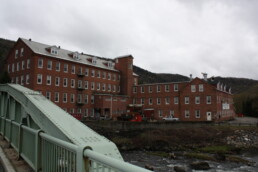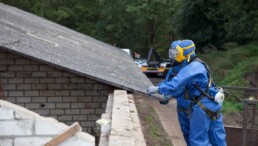Pulp and paper mills have long been one of the most hazardous workplaces for asbestos exposure, and those in Berlin and Gorham, New Hampshire are no exception. These mills, originally owned by the Berlin Mills Company, later renamed Brown Paper Company (Brown Company), played a pivotal role in the social and economic development of both towns. At their peak, the mills employed thousands of workers, transforming Berlin and Gorham into thriving New England mill towns. By 1917, the Brown Company operated three paper mills and owned 4,250,000 acres of timberland, making it the largest pulp and paper manufacturer in the world, and earning Berlin the nickname “the city that trees built”. Key facilities included the mills in Berlin and the Cascade Mill, a few miles down the road in Gorham, which specialized in finishing papers.
In communities like Berlin and Gorham, the mills became the economic lifeblood of the towns and most of the residents worked, either directly or indirectly, for the Brown Company. The Berlin Sun writes that “at one time Brown Company had six manufacturing divisions: 1) a pulp division producing sulphite and kraft pulps for everything from cellophane and photographic papers to tissue and specialty papers; 2) a paper division producing Nibroc towels, industrial wipes and tissue; 3) Bermico Division which created a bituminized fibre pipe for sewers and underground electric systems; 4) Onco Division which produced a sheeting for shoe insoles, wallets, and handbags; 5) Chemical and Solka-Floc Division which created chemicals like liquid chlorine and caustic soda as well as Solka-Floc, a refined wood cellulose used in cigarette filters and rubber soles, and 6) a lumber division.”
The widespread industrial use of asbestos at the time left these workers exposed to serious health risks, including mesothelioma, a form of cancer that affects the protective lining of the lungs, abdomen, heart, and other major organs in the body. The disease takes decades to develop—typically 20-50 years from initial exposure—and its only known cause is asbestos exposure. Since the mills weren’t shut down for good until 2006, they continue to have lasting health impacts on former mill workers and their families to this day.
Asbestos Exposure in Berlin Mills
Based on our decades of work on behalf of mesothelioma victims and their families, we know that one of the most dangerous sources of workplace asbestos exposure in the country is in pulp and paper mills. Asbestos was ideal for industrial applications because of its resistance to heat, fire, and chemicals, and was widely used in parts and equipment throughout the mills. However, when these asbestos-containing materials had to be repaired, or even during routine upkeep and maintenance, microscopic asbestos fibers could be disturbed and sent into the surrounding environment. Workers in the vicinity unknowingly inhaled these fibers, setting the stage for serious health consequences, including an increased risk of developing mesothelioma later in life.
Mill workers regularly exposed to asbestos during their work in pulp and paper mills owned by the Brown Company include:
- Boilermakers
- Electricians
- Maintenance workers
- Pipefitters
- Machine tenders
- Mechanics
- Carpenters
- Millwrights
- Welders
- Fabricators
- General laborers
- Outside contractors
Every day tasks in the mills routinely brought workers into contact with asbestos-containing parts and equipment. Pumps, valves, gaskets, packing, insulation, and thousands of feet of pipes were all common sources of exposure. Dryer felts, essential to the paper-making process, also contained asbestos. Even the buildings themselves, built with asbestos-laced materials in their walls, ceilings, and roofs, posed a risk during maintenance, renovation, or demolition.
Scheduled shutdowns for cleaning, repair, or maintenance, along with unexpected breakdowns, only intensified the danger. When equipment was offline, every minute counted. Workers and outside contractors alike were called upon to get the mill back online as quickly as possible, exposing many to airborne asbestos fibers without protective equipment, or even knowledge of the risks.
Secondary Asbestos Exposure
The effects of asbestos exposure in Berlin and Gorham were far-reaching, and it wasn’t just mill workers who were exposed. It stands to reason that workers who came into contact with asbestos fibers at work would carry these fibers back home, in their cars and on their clothing. Our clients include the spouses of former Berlin Mills and Cascade Mill workers, as well as their sons and daughters, who are only now beginning to show symptoms of mesothelioma. Wives who regularly laundered contaminated clothing and children who hugged their father when he got home from work, unwittingly breathed asbestos fibers into their lungs.
Contact an Experienced Mesothelioma Attorney
If you believe you or a loved one has developed mesothelioma as a result of their job history, we encourage you to reach out to an experienced mesothelioma lawyer to see if you may be entitled to financial compensation. Shepard O’Donnell’s extensive experience with mesothelioma cases originating in paper mills across Massachusetts and New Hampshire, including the mills in Berlin-Gorham, has resulted in life-changing verdicts or settlements for those suffering from this terrible disease and their families. Our significant collection of evidence regarding asbestos exposure in mills operated by Mead Westvaco, Hollingsworth & Vose, Kimberly Clarke, and Brown Company, includes proprietary information not used by other firms. Contact us for a free, no obligation consultation.








